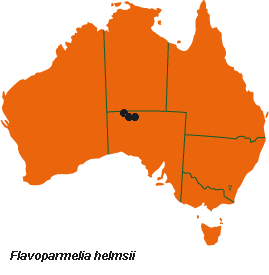



Australian Biological Resources Study
| Checklist of the Lichens of Australia and its Island Territories | ||
| Introduction | A–D | E–O | P–R | S–Z | Oceanic Islands | References | ||
| Flavoparmelia helmsii (Kurok. & Filson) Hale | ||
| Mycotaxon 25: 605 (1986); Parmelia helmsii Kurok. & Filson in R.B.Filson, Austral. J. Bot. 30: 539 (1982). T: Everard Ranges, S.A., 1 June 1891, R.Helms 33; holo: MEL. | ||
| Thallus adnate, to 5–10 cm wide. Lobes imbricate, 1–3 mm wide; margins crenulate; apices rotund. Upper surface dark green to yellow-green, ±rugulose at lobe margins, becoming densely rugulose towards centre, dull to slightly shiny, lacking soredia, dactyls and isidia. Medulla white. Lower surface with sparse, simple rhizines. Apothecia sessile, 2–6 mm wide, crowded at thallus centre; disc concave, cinnamon-brown to dark brown; thalline exciple involute, rugulose. Ascospores 14–18 × 6–9 µm. Pycnidia common. Conidia bacilliform or slightly curved, 8–9 × 1 µm. CHEMISTRY: cortex K-, UV-; medulla K+ very faint brown, C-, KC+ pale brownish orange, P-; containing usnic acid, barbatic acid (major), 4-O-demethylbarbatic acid (trace), ±atranorin and caperatic acid. |  |
|
| Rare, endemic, occurs on bark of trees in central Australia (S.A.). | ||
| Elix (1994g) | ||
| Checklist Index |
| Introduction | A–D | E–O | P–R | S–Z | Oceanic Islands | References |
This work is copyright. Apart from any use as permitted under the Copyright Act 1968, no part may be reproduced by any process without prior written permission from Australian Biological Resources Study. Requests and inquiries concerning reproduction and rights should be addressed in the first instance to Dr P. McCarthy. These pages may not be displayed on, or downloaded to, any other server without the express permission of ABRS.